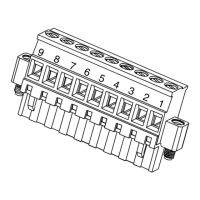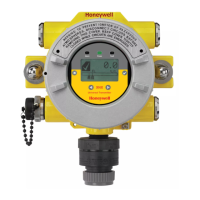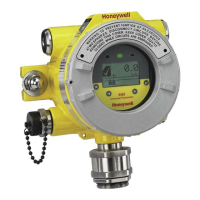XNX Universal Transmitter
Section 3 - Calibration
106
Hydrogen Cyanide
The span calibration can be performed using HCN from a cylinder at
a suitable concentration. Adjust the span calibration set point in the
instrument to match that of the concentration actually applied. Pay
special attention to the following points:
1. Use the ofcial calibration adaptor (S3KCAL) when applying cylinder
gas to the sensor.
2. PTFE tubing should be used to minimise the effects of coating and
gas absorption during the procedure.
3. Tubing lengths should be kept as short as possible.
4. Calibration gas should be owed for a minimum of 5 minutes
through the system before performing a span calibration.
5. A ow rate of 300 to 375 ml/min should be maintained throughout
the calibration procedure.
Fluorine
The calibration is performed using 2 ppm (nominal) chlorine (Cl2).
Honeywell Analytics strongly recommends that a suitable Cl2
generator be used for this operation. Adjust the span calibration set
point in the instrument to match that of the concentration actually
applied. Pay special attention to the following points:
1. Use the ofcial calibration adaptor (S3KCAL) when applying cylinder
gas to the sensor.
2. PTFE tubing should be used to minimise the effects of coating and
gas absorption during the procedure.
3. Tubing lengths should be kept as short as possible.
4. Calibration gas should be owed for a minimum of 5 minutes
through the system before performing a span calibration.
5. A ow rate of 300 to 375 ml/min should be maintained throughout
the calibration procedure.
Ethylene Oxide
Caution: Operation of the EtO sensor in a constant background of ethylene may result in baseline
drift. under these conditions, the response of the sensor should be checked and calibrated more
frequently.
Caution: Exposure of the EtO sensor to high concentrations of ethylene may reduce cell life. After
such an exposure, check and if necessary replace the sensor.
!
To maximize the accuracy of the calibration, please follow the special
process for calibration of EtO cartridges as follow:
Transportation and Installation
Note: Ethylene oxide sensors are supplied on a transportation board in order to keep the cell biased
at the correct level. Once removed from the transportation board the sensor should be tted to the
detector as soon as possible.
!
If the sensor is not tted to the transportation board or a powered
detector, its bias will decay and the sensor will take up to 24 hours
to recover. During this period the sensor will not function as a gas
detector, reporting a gas reading above full scale.
When calibrating ethylene oxide sensors, the following should be
taken into account:
1. Use the ofcial calibration adaptor (S3KCAL) when applying cylinder
gas to the sensor.
2. PTFE tubing should be used to minimise the effects of coating and
gas absorption during the procedure.
3. Tubing lengths should be kept as short as possible.
4. Calibration gas should be owed for a minimum of 5 minutes
through the system before performing a span calibration.

